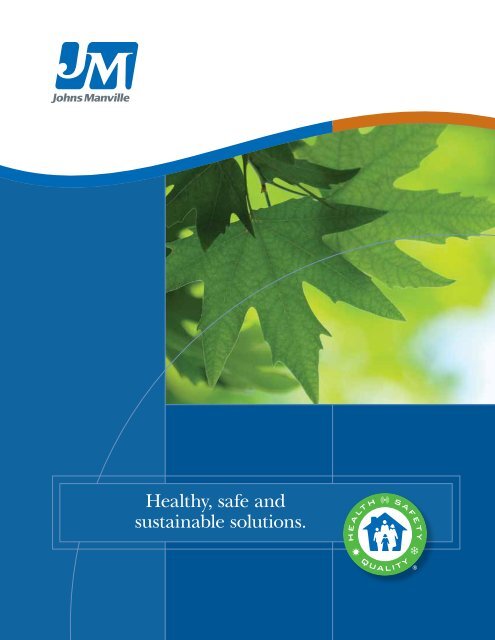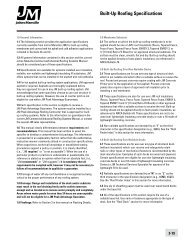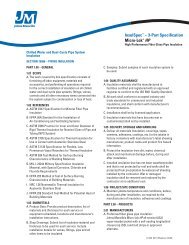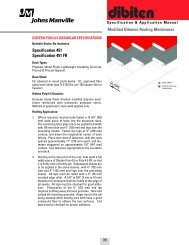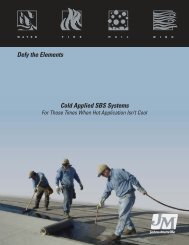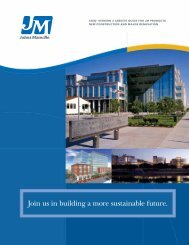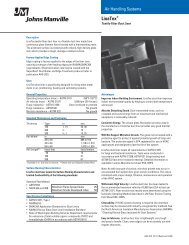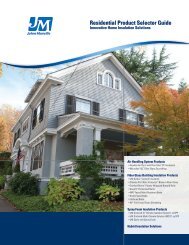JM Sustainability Brochure - Johns Manville
JM Sustainability Brochure - Johns Manville
JM Sustainability Brochure - Johns Manville
Create successful ePaper yourself
Turn your PDF publications into a flip-book with our unique Google optimized e-Paper software.
Healthy, safe and<br />
sustainable solutions.<br />
®
How we can help your company.<br />
<strong>Johns</strong> <strong>Manville</strong> fiber glass is<br />
a healthier and safer choice,<br />
made with sustainable materials.<br />
Our products are specifically developed for<br />
performance with health, safety and quality in mind.<br />
First and foremost, we’re concerned with the health,<br />
comfort and well-being of a building’s occupants.<br />
Second, our products are designed to promote and<br />
support sustainable building practices.<br />
These benefits help improve indoor air quality and<br />
offer a sustainable alternative for earning points in a<br />
variety of green programs such as the LEED ® green<br />
building certification program.<br />
<strong>Johns</strong> <strong>Manville</strong> fiber glass can eliminate or reduce<br />
volatile organic compounds (VOCs) in your products.<br />
That’s because we offer certified Formaldehyde-free fiber glass insulation, helping you remove one potential<br />
source of formaldehyde from a wide variety of thermal,<br />
acoustical and mechanical products.<br />
Fiber glass applications include:<br />
n Aerospace<br />
n Air handling<br />
n Appliance<br />
n Building insulation<br />
n HVAC<br />
n Office interiors<br />
n Pipe and equipment<br />
n Transportation
Fiber glass. The safe,<br />
sustainable insulation<br />
with proven performance.<br />
Fiber glass offers proven thermal and acoustic performance.<br />
One of the most thoroughly tested building materials,<br />
fiber glass has been proven safe for both workers in your<br />
facilities and those who ultimately use the products<br />
you offer.<br />
Fiber glass is also sustainable, made with both readily<br />
available local materials and recycled content.<br />
FibeR glass is saFe.<br />
In an age when few companies are willing to<br />
make categorical statements, we offer this:<br />
Fiber glass is safe.<br />
<strong>JM</strong> doesn’t offer that statement as opinion, but as fact<br />
based on the most recent long-term research and<br />
published results from some of the world’s most respected<br />
health organizations.<br />
Over the years, fiber glass has been rigorously studied by<br />
government and independent research organizations.<br />
Their conclusions show that fiber glass is safe as a finished<br />
product or as a product component, and it is safe for<br />
workers who make or install the product when they<br />
follow simple work practices to avoid temporary<br />
mechanical irritation.<br />
the ReseaRch.<br />
In 2000, the U.S. National Academy of Sciences found<br />
“no significant association between fiber exposure<br />
and lung cancer or nonmalignant respiratory disease<br />
in the MMVF (man-made vitreous fiber) manufacturing<br />
environment.”<br />
U.S. National Academy of Sciences<br />
In 2001, the World Health Organization’s International<br />
Agency for Research on Cancer (IARC) removed fiber<br />
glass insulation from its list of possible carcinogens.<br />
According to the agency, “studies…provide no<br />
evidence of increased risks of lung cancer or of<br />
mesothelioma from occupational exposures during<br />
manufacture of these materials, and inadequate<br />
evidence overall of any cancer risk.”<br />
World Health Organization<br />
The U.S. Department of Health and Human Services’<br />
Agency for Toxic Substances and Disease Registry<br />
(ATSDR) stated in 2004 that “studies showed no<br />
consistent evidence of disease among groups<br />
of workers involved in the manufacture of SVFs<br />
(synthetic vitreous fibers).”<br />
U.S. Department of<br />
Health & Human Services<br />
<strong>Johns</strong> <strong>Manville</strong> Fiber Glass 2
Fiber glass.<br />
A sustainable material.<br />
Recycled content.<br />
According to the North American Insulation Manufacturs<br />
Association, fiber glass insulation is the largest secondary<br />
market for recycled glass containers. The recycled glass<br />
used in fiber glass insulation saves more than 27 million<br />
cubic feet of landfill space every year. That’s 2.2 billion<br />
pounds of recycled post-consumer glass.<br />
What’s not made from recycled materials is<br />
made mostly from sand, an abundant and rapidly<br />
replenished resource.<br />
When a building is remodeled or demolished, fiber<br />
glass batts, rolls and loose fill can often be reused.<br />
Regionally oR locally PRoduced.<br />
Because fiber glass is made with a readily available<br />
resource and recycled content, it can be locally or<br />
regionally produced. That fact is extremely important<br />
when looking at fuel consumption and its<br />
environmental impact.<br />
As a result of being locally produced, much less fuel is<br />
consumed as the fiber glass makes its way from the<br />
manufacturer to those who use it. And in its final form,<br />
some fiber glass insulation can be highly compressed<br />
when packaged, requiring less packaging and less space<br />
in transit, which further reduces fuel demands.<br />
For more than 60 years,<br />
the performance of fiber glass<br />
has undergone continual improvement<br />
through engineering and design<br />
to enhance its affordability and<br />
efficiency.<br />
today, fiber glass offers a costeffective<br />
solution that safely provides<br />
excellent thermal and acoustic<br />
performance.<br />
3 <strong>Johns</strong> <strong>Manville</strong> Fiber Glass<br />
will not suPPoRt mold gRowth.<br />
Mold requires an organic material as a food source. As<br />
an inorganic fiber, fiber glass is naturally resistant to mold<br />
growth. In addition, several <strong>Johns</strong> <strong>Manville</strong> fiber glass<br />
products are treated with an EPA-approved mold inhibitor<br />
to protect them from mold-related damage. These include<br />
MR ® Faced batts, <strong>JM</strong> Spider ® Custom Insulation System, pipe<br />
jacketing, HVAC duct liner and duct board products.<br />
natuRally FiRe Resistant.<br />
Unlike many organic insulations, fiber glass does not require<br />
toxic fire retardants. Fire retardants may leach out of other<br />
insulation types over time, leaving them without protection<br />
from heat and flame.<br />
insulates well and PRevents Pollution.<br />
Efficient thermal insulation is fundamental to energy<br />
efficiency and cost reductions. By reducing the demand<br />
for energy, it reduces the pollutants created by energy<br />
generation and ultimately saves money that would be spent<br />
on heating or cooling.<br />
ceRtiFied Recycled content.<br />
Certified by an independent testing laboratory (Scientific<br />
Certification Systems), many of our insulation products<br />
contain a North American average of<br />
25 percent recycled glass content, with at<br />
least 20 percent being post-consumer glass.<br />
We also recycle our own glass, though the<br />
amounts are not included in these figures.
The best choice across the board.<br />
Fiber Glass Compared to other insulation materials.<br />
buildinG insulation<br />
insulation type<br />
thermal<br />
Conductivity<br />
noise reduction Coefficient<br />
(nrC)<br />
limited<br />
Combustibility<br />
Fiber Glass ++ +++ yes<br />
Mineral Wool ++ +++ yes<br />
Foam<br />
Closed Cell +++ + no<br />
Open Cell + ++ no<br />
Cellulose + +++ —<br />
Note: Comparison of relative performance in typical applications.<br />
+ = Good, ++ = Better, +++ = Best.<br />
Source: Various industry data.<br />
eQuipment insulation<br />
insulation type<br />
thermal<br />
Conductivity<br />
noise reduction Coefficient<br />
(nrC)<br />
limited<br />
Combustibility<br />
Fiber Glass +++ +++ yes<br />
Textile Glass ++ +++ yes<br />
Synthetics<br />
Polyester ++ ++ no<br />
Melt Blown Polypropylene ++ +++ no<br />
Mineral Wool +++ +++ yes<br />
Cotton Shoddy ++ ++ no<br />
Foam<br />
Elastomeric + ++ no<br />
Polyolefin ++ + no<br />
Melamine +++ +++ no<br />
Note: Comparison of relative performance in typical applications.<br />
+ = Good, ++ = Better, +++ = Best.<br />
Source: Various industry data.<br />
<strong>Johns</strong> <strong>Manville</strong> Fiber Glass<br />
4
Fiber Glass Contributes to sustainable innovation and desiGn.<br />
Comparison oF Key Fiber properties<br />
Fiber type Glass polypropylene polyester nylon 6,6 organic Fibers *<br />
Moisture Absorbency Resistance +++ +++ +++ ++ +<br />
Strength +++ ++ ++ ++ ++<br />
Fire Resistance +++ + + + +<br />
Temperature Resistance +++ + + + ++<br />
Abrasion Resistance + +++ +++ +++ ++<br />
Acid Resistance +++ +++ +++ + +<br />
Alkali Resistance +++ +++ ++ +++ +++<br />
*Organic fibers include cotton, hemp, jute, flax and kenaf.<br />
Source: Kadolf, Langford, Hollen and Saddler: “Textiles, Seventh Edition”, Macmillan Publishing Company.<br />
Glass<br />
Nylon 6,6<br />
relative Fiber strength<br />
Polyester<br />
Polypropylene<br />
Cotton<br />
Source: Kadolf, Langford, Hollen and Saddler: “Textiles, Seventh Edition,” Macmillan Publishing Company.<br />
Polymeric Materials Encyclopedia, Volume 11 T-Z, CRC Press.<br />
Jute<br />
Note: Comparison of relative performance in typical applications.<br />
+ = Good, ++ = Better, +++ = Best.<br />
Glass<br />
Polypropylene<br />
relative moisture absorbency<br />
Polyester<br />
Nylon 6,6<br />
Cotton<br />
Source: Kadolf, Langford, Hollen and Saddler: “Textiles, Seventh Edition,” Macmillan Publishing Company<br />
Polymeric Materials Encyclopedia, Volume 11 T-Z, CRC Press.<br />
Hemp<br />
Jute<br />
<strong>Johns</strong> <strong>Manville</strong> Fiber Glass<br />
5
the white insulation<br />
that’s quite gReen.<br />
Taking a SuSTainable MaTerial<br />
Several STepS FurTher.<br />
Any thermal insulation contributes to the environment<br />
to some degree simply by reducing energy loss and<br />
the emissions associated with energy use.<br />
At <strong>Johns</strong> <strong>Manville</strong>, that’s just the start. We take our<br />
ecological responsibilities very seriously and strive to<br />
be good stewards of the environment.<br />
here’s how we’re working<br />
to protect the environment<br />
while making a healthier,<br />
high-quality insulation.<br />
iMproving indoor and ouTdoor air QualiTy.<br />
Because we’ve removed the formaldehyde from all of our<br />
building insulation products, we’ve also eliminated binderrelated<br />
formaldehyde emissions during manufacturing.<br />
In fact, our building insulation plants are so low emitting,<br />
they were the first ones in our industry exempt from<br />
EPA Hazardous Air Pollutant Regulations.<br />
These pollution prevention measures have reduced<br />
<strong>Johns</strong> <strong>Manville</strong>’s hazardous pollutant emissions by<br />
more than 200,000 pounds annually.<br />
6 <strong>Johns</strong> <strong>Manville</strong> Fiber Glass<br />
when given the choice,<br />
89 percent of homeowners<br />
prefer building materials<br />
made without formaldehyde<br />
and 79 percent are willing<br />
to pay a premium.<br />
Proprietary <strong>JM</strong> Brand<br />
Positioning Research<br />
the tRouble with FoRmaldehyde.<br />
In 2002, <strong>Johns</strong> <strong>Manville</strong> converted its entire line of building<br />
insulation to formulations that do not contain added<br />
formaldehyde. Prior to 2002, there had been limited use of<br />
acrylic binders to replace formaldehyde by <strong>Johns</strong> <strong>Manville</strong><br />
and its competitors, and <strong>JM</strong>’s conversion was the first<br />
full-scale application of the technology.<br />
The decision to make such a monumental change was based<br />
on good market research and the realization that social, legal<br />
and regulatory trends were moving toward stricter control<br />
of formaldehyde. Research also revealed that, given the<br />
choice, 89 percent of consumers would choose insulation<br />
materials made without formaldehyde and 79 percent would<br />
pay a premium for them.<br />
<strong>JM</strong> certified Formaldehyde-free fiber glass insulation—as a<br />
smart alternative to formaldehyde-based building materials —<br />
helps achieve a healthier and safer building by reducing overall<br />
indoor formaldehyde exposure. <strong>JM</strong> Formaldehyde-free fiber<br />
glass insulation also helps meet California EPA recommendations<br />
to use building materials (including insulation) with no added<br />
formaldehyde and U.S. EPA recommendations to minimize your<br />
exposure to formaldehyde.<br />
Since 2002, <strong>JM</strong> has steadfastly worked at converting as<br />
many of our fiber glass products as possible to an acrylic<br />
formulation. We now make 80 percent of our Insulation<br />
Systems products without added formaldehyde.
the <strong>Johns</strong> manville<br />
advantage: imPRoved<br />
indooR aiR quality.<br />
<strong>Johns</strong> <strong>Manville</strong> has taken the benefits and proven<br />
performance of fiber glass—its proven safety, it’s<br />
thermal and acoustic insulating abilities and its<br />
environmental sustainability—and created an even<br />
safer product line.<br />
By developing a patented process that uses an<br />
acrylic binder, <strong>JM</strong> has completely eliminated the<br />
use of formaldehyde in many of our fiber glass<br />
products.<br />
As a result, you can use <strong>JM</strong> certified<br />
Formaldehyde-free fiber glass to eliminate or<br />
reduce formaldehyde and VOCs in your products,<br />
too, from acoustic panels and partitions to air<br />
conditioners and many other products.<br />
“... it is best to limit that<br />
amount of [formaldehyde]<br />
exposure as much as<br />
possible.”<br />
7 <strong>Johns</strong> <strong>Manville</strong> Fiber Glass<br />
2005 Comments of<br />
U.S. EPA on LEED-NC<br />
Version 2.2’s Proposed<br />
Indoor Environmental<br />
Quality Prerequisite<br />
Passing the test.<br />
<strong>JM</strong>’s Formaldehyde-free fiber glass products have been<br />
tested by an independent, nationally recognized laboratory to<br />
determine emissions of toxic VOCs. In contrast to “certified<br />
low-emitting products,” Formaldehyde-free insulation<br />
achieves non-detect for formaldehyde in rigorous IAQ testing.<br />
The Home Safety Council’s Commendation<br />
awards manufacturers for innovative products<br />
that improve consumer safety. In 2006,<br />
<strong>Johns</strong> <strong>Manville</strong> earned a commendation<br />
award for Product Innovation for Consumer<br />
Safety for Formaldehyde-free fiber glass<br />
building insulation. The Council wrote that<br />
<strong>JM</strong>’s “home safety product innovations…<br />
demonstrate a clear commitment to health<br />
and safety.”<br />
<strong>JM</strong> Formaldehyde-free fiber glass insulation<br />
also meets the stringent rules of Canada’s<br />
Environmental Choice Program. Only fiber<br />
glass batt insulation without formaldehyde<br />
can earn the program’s EcoLogo .
With sustainable building practices,<br />
we’ll help you get the point.<br />
Using <strong>Johns</strong> <strong>Manville</strong> Formaldehyde-free fiber glass contributes<br />
to prerequisite and point opportunities with:<br />
n The Leadership in Energy and Environmental Design (LEED)<br />
program developed by the U.S. Green Building Council ® .<br />
n National Institute of Standards and Technology’s Building<br />
for Environmental and Economic <strong>Sustainability</strong> (BEES 3.0)<br />
program.<br />
n U.S. Army Corps of Engineers’ Sustainable Project Rating<br />
Tool (SPiRiT) program.<br />
We can also help builders and manufacturers through many<br />
of the other rating systems that judge sustainable building<br />
practices, including:<br />
n Austin Green Builder Program<br />
n Green Guide for Health Care<br />
n Built Green Colorado<br />
n NAHB Green Guidelines<br />
… and a wide range of other national, state and local programs.<br />
Leading you through Leed.<br />
As a charter member of the U.S. Green Building Council,<br />
<strong>Johns</strong> <strong>Manville</strong> has the knowledge necessary to help you with<br />
your sustainable building efforts.<br />
In fact, <strong>JM</strong> fiber glass insulation helps contribute to LEED<br />
certification points in three of the five major credit areas:<br />
1. Materials and Resources (recycled content)<br />
2. Energy and Atmosphere (thermal performance)<br />
3. Indoor Environmental Quality (Formaldehyde-free <br />
insulation)<br />
<strong>JM</strong> can help you earn LEED points in all phases of your project,<br />
with products ranging from building insulation to roofing<br />
systems, building wrap, mechanical insulation and wall coverings.<br />
For more information on how we can help your business,<br />
call us at (800) 654-3103 or visit www.spec<strong>JM</strong>.com. We’ll be happy<br />
to send you our detailed LEED Credits Guide #HIG-1231.<br />
Or if you prefer, ask to speak to one of our LEED specialists.<br />
We’ll answer your questions and help in any way we can to<br />
keep your project moving forward, efficiently and within<br />
the program guidelines.<br />
<strong>JM</strong> is the singLe<br />
source for aLL your<br />
insuLation needs.<br />
<strong>Johns</strong> <strong>Manville</strong>, a Berkshire Hathaway<br />
company, is a leading manufacturer<br />
and marketer of premium-quality<br />
building insulation, mechanical<br />
insulation, commercial roofing, roof<br />
insulation and specialty products<br />
for commercial, industrial and<br />
residential applications.<br />
<strong>JM</strong>’s product offerings include<br />
Formaldehyde-free fiber glass<br />
building insulation, commercial roofing<br />
membranes and roof insulations,<br />
filtration media, thermal and acoustic<br />
insulation, mats and reinforcements.<br />
<strong>JM</strong> is the single source for your<br />
insulation needs in the Aerospace,<br />
Air Handling, Appliance, Building<br />
Insulation, HVAC, Office Interiors,<br />
Pipe and Equipment, and Transportation<br />
markets. We are your partner in<br />
problem solving, offering years of<br />
experience, timely and accurate<br />
answers and a broad range of<br />
technologies. Our internationally<br />
accredited Analytical and Testing<br />
Labs provide the following capabilities:<br />
• Acoustical technology<br />
• Analytical chemistry<br />
• Industrial hygiene<br />
• Microstructural analysis<br />
• Physical and fire test<br />
• Thermal technology<br />
<strong>Johns</strong> <strong>Manville</strong> Fiber Glass<br />
iv 8
<strong>JM</strong>COM110050<br />
Printed on recycled paper.<br />
a a<br />
a a<br />
717 17th St.<br />
Denver, CO 80202<br />
(800) 654-3103<br />
spec<strong>JM</strong>.com<br />
BID-0103 03/11 (Replaces 05/10)<br />
© 2011 <strong>Johns</strong> <strong>Manville</strong>. Printed in USA.


